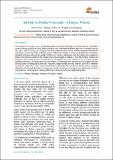| dc.contributor.author | M. O. 1. Otieno J., Abong’o, S and .Wagah | |
| dc.date.accessioned | 2022-01-24T11:02:39Z | |
| dc.date.available | 2022-01-24T11:02:39Z | |
| dc.date.issued | 2020 | |
| dc.identifier.issn | 2637-5885 | |
| dc.identifier.uri | https://repository.maseno.ac.ke/handle/123456789/4628 | |
| dc.description.abstract | The purpose of the paper was to investigate barriers to pottery production in Kenyan prisons. Descriptive
research design guided the study. Both qualitative and quantitative methods were used to analyse data in
the study. Areas of study were Lang’ata, and Kisii women prisons. A total of 486 respondents formed the
population of the study which included inmates, Officers-in-Charge of prisons and illustrators. Purposive
sampling technique was used to sample 2 Officers-in-charge, 4 illustrators and 30 inmates who engaged in
pottery, thus leaving a total of 450 inmates who did not engage in pottery. From 450 inmates, Krejcie and
Morgan’s table was used to get a sample size of 205 inmates who were selected by use of simple random
sampling technique. The study found out that pottery is confronted with barriers such as negative attitude
towards pottery, inadequate facilities and resources, inappropriate teaching methods and lack of refresher
training for illustrators. The study recommended that authorities concerned should ensure adequate
allocation of funds and illustrators to undertake refresher training so as to equip them with modern mode of
production for transmission of relevant skills to the inmates to assist them with reintegration | en_US |
| dc.publisher | sryahwapublications | en_US |
| dc.subject | Pottery, Techniques, Education, Production, Inmates | en_US |
| dc.title | Barriers to Pottery Production in Kenyan Prisons | en_US |
| dc.type | Article | en_US |

